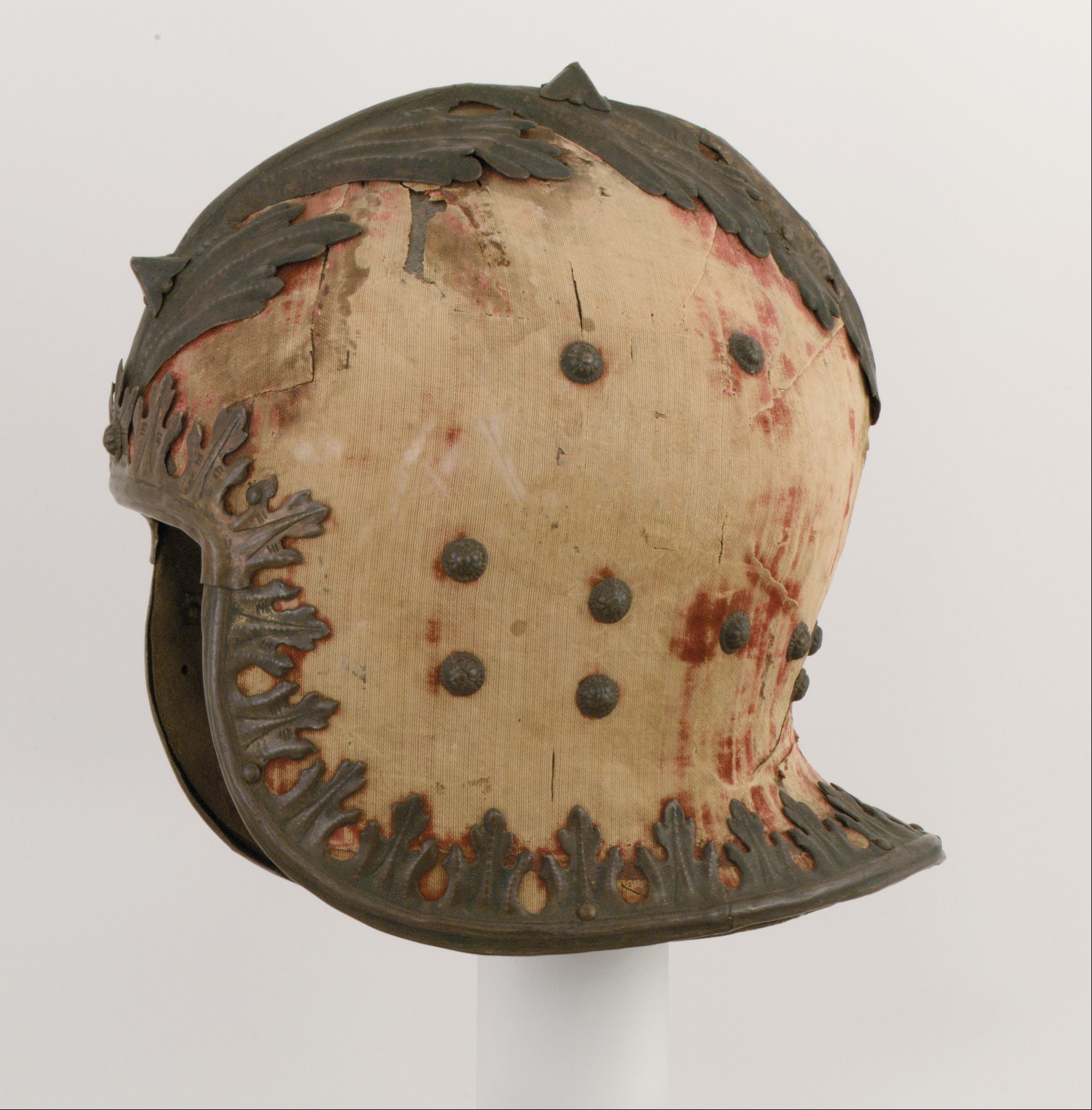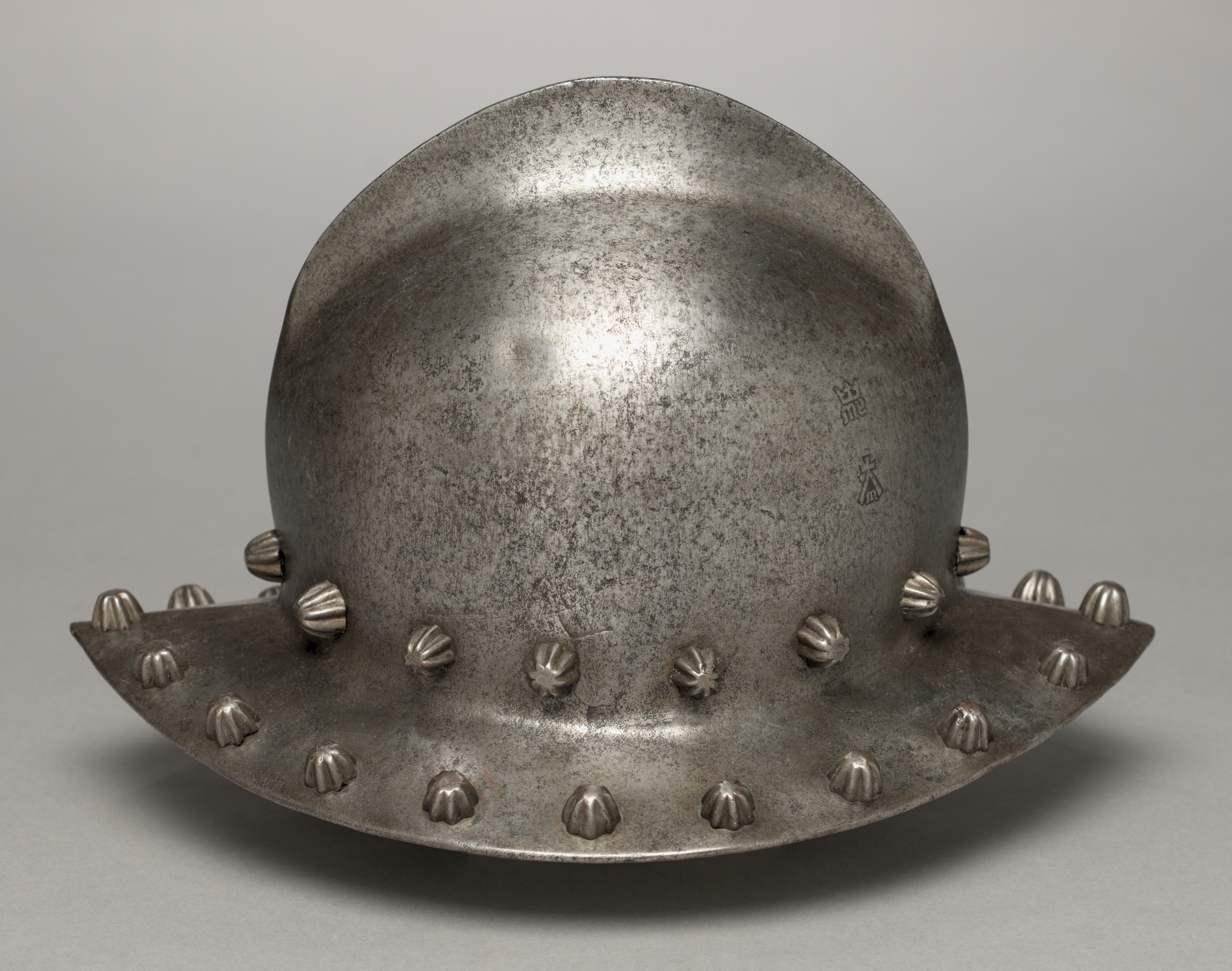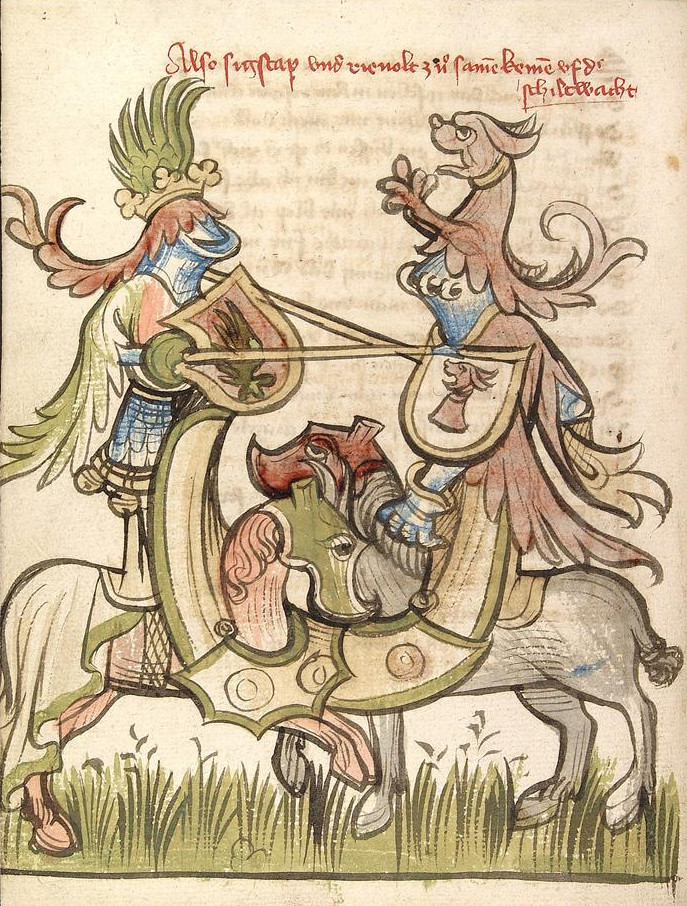|
Salade
The sallet (also called ''celata,'' ''salade'' and ''schaller'') was a combat helmet that replaced the bascinet in Italy, western and northern Europe and Hungary during the mid-15th century. In Italy, France and England the armet helmet was also popular, but in Germany the sallet became almost universal. Origins The origin of the sallet seems to have been in Italy, where the term ''celata'' is first recorded in an inventory of the arms and armour of the Gonzaga family dated to 1407. In essence, the earliest sallets were a variant of the bascinet, intended to be worn without an aventail or visor. To protect the face and neck, left exposed by abandonment of the visor and aventail, the rear was curved out into a flange to protect the neck, and the sides of the helmet were drawn forward below the level of the eyes to protect the cheeks. The latter development was most pronounced in the barbute or ''barbuta,'' a variation of the sallet that adopted elements of Classical Corinthian h ... [...More Info...] [...Related Items...] OR: [Wikipedia] [Google] [Baidu] |
Sallet "in The Venetian Style" MET DP22327
The sallet (also called ''celata,'' ''salade'' and ''schaller'') was a combat helmet that replaced the bascinet in Italy, western and northern Europe and Hungary during the mid-15th century. In Italy, France and England the armet helmet was also popular, but in Germany the sallet became almost universal. Origins The origin of the sallet seems to have been in Italy, where the term ''celata'' is first recorded in an inventory of the arms and armour of the Gonzaga family dated to 1407. In essence, the earliest sallets were a variant of the bascinet, intended to be worn without an aventail or visor. To protect the face and neck, left exposed by abandonment of the visor and aventail, the rear was curved out into a flange to protect the neck, and the sides of the helmet were drawn forward below the level of the eyes to protect the cheeks. The latter development was most pronounced in the barbute or ''barbuta,'' a variation of the sallet that adopted elements of Classical Corinthian helm ... [...More Info...] [...Related Items...] OR: [Wikipedia] [Google] [Baidu] |
Standard (mail Collar)
A standard, also called a pizaine, was a collar of mail often worn with plate armour. Construction The standard protected the throat and neck and usually extended over the shoulders; it was in use from the 14th to the 16th century. Unlike the similar aventail, it was not attached to a helmet. It was called a standard because the part encircling the neck and throat was able to stand upright without any external stiffening. This part of the standard was composed of links joined 6-in-1, which made it less flexible and also stronger; the usual, more flexible, ratio of mail linking was 4-in-1. The lower, shoulder-covering, part of the standard was of 4-in-1 linked mail. Some standards were decorated with edging in brass or bronze links (sometimes gilded), and/or were given a zig-zag lower edge (vandyked). Use Standards were sometimes worn under an aventail, or even a gorget, for extra protection. However, standards were often worn without other neck protection by soldiers who valued a ... [...More Info...] [...Related Items...] OR: [Wikipedia] [Google] [Baidu] |
Metropolitan Museum Of Art
The Metropolitan Museum of Art of New York City, colloquially "the Met", is the largest art museum in the Americas. Its permanent collection contains over two million works, divided among 17 curatorial departments. The main building at 1000 Fifth Avenue, along the Museum Mile on the eastern edge of Central Park on Manhattan's Upper East Side, is by area one of the world's largest art museums. The first portion of the approximately building was built in 1880. A much smaller second location, The Cloisters at Fort Tryon Park in Upper Manhattan, contains an extensive collection of art, architecture, and artifacts from medieval Europe. The Metropolitan Museum of Art was founded in 1870 with its mission to bring art and art education to the American people. The museum's permanent collection consists of works of art from classical antiquity and ancient Egypt, paintings, and sculptures from nearly all the European masters, and an extensive collection of American and modern ... [...More Info...] [...Related Items...] OR: [Wikipedia] [Google] [Baidu] |
Close Helm
The close helmet or close helm is a type of combat helmet that was worn by knights and other men-at-arms in the Late Medieval and Renaissance eras. It was also used by some heavily armoured, pistol-armed, cuirassiers into the mid-17th century. It is a fully enclosing helmet with a pivoting visor and integral bevor. Characteristics The close helmet was developed from the later versions of the sallet and the superficially similar armet in the late 15th century. In contemporary sources it was sometimes also referred to as an "armet", though modern scholarship draws a clear distinction between the two types. While outwardly very similar to the armet, the close helmet had an entirely different method of opening. Like the armet, the close helmet followed the contours of the head and neck closely, and narrowed at the throat, therefore it required a mechanical method for opening and closing. While an armet opened laterally using two large hinged cheekpieces, a close helmet instead ope ... [...More Info...] [...Related Items...] OR: [Wikipedia] [Google] [Baidu] |
Firefighter's Helmet
For centuries, firefighters have worn helmets to protect them from heat, cinders and falling objects. Although the shape of most fire helmets has changed little over the years, their composition has evolved from traditional leather to metals (including brass, nickel and aluminum), to composite helmets constructed of lightweight polymers and other plastics. Leather helmets The original American fire helmet was created by a New York City luggage maker who was also a volunteer fireman in the 1830s, seeking a better design more tailored to the unique requirements for firefighting than the "stovepipe" "helmets" then in use. Stovepipe was essentially a top hat made of stiff leather with painted design to identify fire company and provided no protection.Leather was chosen as the preferred material both because it was what the man, Henry Gratacap, was familiar with, but also because thick treated leather was flame-resistant and highly resistant to breaking apart. ''Leatherhead'' is a ... [...More Info...] [...Related Items...] OR: [Wikipedia] [Google] [Baidu] |
Kettle Hat
A kettle hat, also known as a war hat, is a type of helmet made of iron or steel in the shape of a brimmed hat. There are many design variations. The only common element is a wide brim that afforded extra protection to the wearer. It gained its common English language name from its resemblance to a metal cooking pot (the original meaning of ''kettle''). The kettle hat was common all over Medieval Europe. It was called ''Eisenhut'' in German and ''chapel de fer'' in French (both names mean "iron hat" in English). Characteristics and use Though similar brimmed helmets are depicted in illustrations of the Carolingian period, their use seems to have disappeared soon after. In the late 12th century, alongside the development of the enclosed helmet, the brimmed helmet makes a reappearance in Western Europe. Also in the 12th century the brimmed helmet begins to be depicted in Byzantine art, and it has been suggested that it was a Byzantine development. Early examples were made in the ... [...More Info...] [...Related Items...] OR: [Wikipedia] [Google] [Baidu] |
Stahlhelm
The ''Stahlhelm'' () is a German military steel combat helmet intended to provide protection against shrapnel and fragments of grenades. The term ''Stahlhelm'' refers both to a generic steel helmet and more specifically to the distinctive German military design. The armies of major European powers introduced helmets of this type during World War I. The German Army began to replace the traditional boiled leather '' Pickelhaube'' () with the ''Stahlhelm'' in 1916. The ''Stahlhelm'', with its distinctive "coal scuttle" shape, was instantly recognizable and became a common element of propaganda on both sides, just like the ''Pickelhaube'' before it. The name was also used by ''Der Stahlhelm'', a post–World War I organization for German ex-servicemen that existed from 1918 to 1935. After World War II, the German () continued to call their standard helmet ''Stahlhelm'', but the design was based on the American M1 helmet. The '' Bundesgrenzschutz'' (), however, continued to us ... [...More Info...] [...Related Items...] OR: [Wikipedia] [Google] [Baidu] |
Jousting
Jousting is a martial game or hastilude between two horse riders wielding lances with blunted tips, often as part of a tournament (medieval), tournament. The primary aim was to replicate a clash of heavy cavalry, with each participant trying to strike the opponent while riding towards him at high speed, breaking the lance on the opponent's shield or jousting armour if possible, or unhorsing him. The joust became an iconic characteristic of the knight (stock character), knight in Romantic medievalism. The participants experience close to three and a quarter times their body weight in G-forces when the lances collide with their armour. The term is derived from Old French , ultimately from Latin "to approach, to meet". The word was loaned into Middle English around 1300, when jousting was a very popular sport among the Anglo-Normans, Anglo-Norman knighthood. The synonym tilt (as in tilting at windmills) dates . Jousting is based on the military use of the lance by heavy cavalry. ... [...More Info...] [...Related Items...] OR: [Wikipedia] [Google] [Baidu] |
Burgonet
The burgonet helmet (sometimes called a burgundian sallet) was a Renaissance-era and early modern combat helmet. It was the successor of the sallet. Characteristics The burgonet helmet is characterised by a skull with a large fixed or hinged peak projecting above the face-opening, and usually an integral, keel-like, crest or comb running from front to rear. Attached to the skull are substantial hinged cheekpieces which usually do not meet at the chin or throat. A flange projects from the lower parts of the skull and cheekpieces to protect the back and sides of the neck. Though typically a relatively light helmet and open faced, a falling buffe, a sort of visor that was closed by being drawn up rather than down, was sometimes used. Some helmets, often termed "close burgonets", were made which took elements, such as the peak, crest and falling buffe, of the burgonet and combined them with the hinged bevor of the close helmet. Use Commonplace throughout Europe, it first came into ... [...More Info...] [...Related Items...] OR: [Wikipedia] [Google] [Baidu] |
Close Helmet
The close helmet or close helm is a type of combat helmet that was worn by knights and other men-at-arms in the Late Medieval and Renaissance eras. It was also used by some heavily armoured, pistol-armed, cuirassiers into the mid-17th century. It is a fully enclosing helmet with a pivoting visor and integral bevor. Characteristics The close helmet was developed from the later versions of the sallet and the superficially similar armet in the late 15th century. In contemporary sources it was sometimes also referred to as an "armet", though modern scholarship draws a clear distinction between the two types. While outwardly very similar to the armet, the close helmet had an entirely different method of opening. Like the armet, the close helmet followed the contours of the head and neck closely, and narrowed at the throat, therefore it required a mechanical method for opening and closing. While an armet opened laterally using two large hinged cheekpieces, a close helmet instead ope ... [...More Info...] [...Related Items...] OR: [Wikipedia] [Google] [Baidu] |
Duke Of Burgundy
Duke of Burgundy (french: duc de Bourgogne) was a title used by the rulers of the Duchy of Burgundy, from its establishment in 843 to its annexation by France in 1477, and later by Holy Roman Emperors and Kings of Spain from the House of Habsburg who claimed Burgundy proper and ruled the Burgundian inheritance in the Low Countries. The Duchy of Burgundy was a small portion of the traditional lands of the Burgundians west of the river Saône which, in 843, was allotted to Charles the Bald's West Franks, kingdom of West Franks. Under the Ancien Régime, the Duke of Burgundy was the premier lay Peerage of France, peer of the kingdom of France. Beginning with Robert II of France, the title was held by the House of Capet, Capetians, the French royal family. It was granted to Robert's younger son, Robert I, Duke of Burgundy, Robert, who founded the House of Burgundy. When the senior line of the House of Burgundy became extinct, it was inherited by John II of France through proximity of ... [...More Info...] [...Related Items...] OR: [Wikipedia] [Google] [Baidu] |
Coventry Sallet
The Coventry Sallet is a 15th-century helmet now on display at Herbert Art Gallery and Museum. English sallets have been considered both rare and important.The Times, 13 August 1927: Arms And Armour. New Exhibits At Victoria And Albert Museum Description The Sallet is 11 inches (27.9 cm) in height, 12.25 inches (31.1 cm) from front to back and is 7.75 inches (17.9 cm) wide. It weighs 5.25 pounds (2.4 kg). It has a short tail and a jawbone type visor with a brow reinforcing. Stylistically, it is termed a "high crowned" helmet, different from the style usually seen in Italy or Germany. A plume holder was added to the helmet at some time after its manufacture. History The helmet was made around 1460, during the period of English civil conflict known as the Wars of the Roses, and the armourer's marks suggest that it was made by an artisan originating from Italy. During the 19th century it was used in Coventry's Godiva Procession. For a period it was kept on di ... [...More Info...] [...Related Items...] OR: [Wikipedia] [Google] [Baidu] |









.png)
